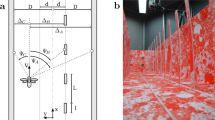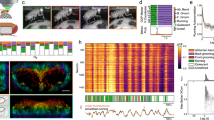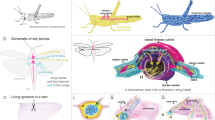Abstract
Animals use their senses to extract information from the world around them, so they need to be able to gauge the physical properties of their environment in order to build up an accurate perception of it. For example, a bat needs to ‘know’ the velocity of sound to estimate how far away an object is, although input to a sensory system may often exploit more complicated properties than this. Here we measure the response by the wind-sensing system of the American cockroach (Periplaneta americana) to a complex hydrodynamic flow. We find that the insect's interneurons relay crucial information about the wind's spectral properties, which may warn it of approaching predators.
Similar content being viewed by others
Main
The cockroach senses minute air movements using tiny hairs on two posterior appendages called cerci1. It can surmise the direction of an attack and scurry away to avoid being eaten. Neural signals from the hairs converge on the terminal abdominal ganglion where the wind information is processed, and are then conveyed further by giant interneurons. Although this system has many of the properties of more complex systems, it remains simple enough to be tractable for study.
We produced random wind stimuli with defined spectral properties and measured the average firing rates of several interneurons in response to this stimulus. For a given spectral shape, the total power of the stimulus did not change the steady-state firing rates of the interneurons (Fig. 1a ). Changing the high-frequency roll-off, on the other hand, strongly influenced the firing rates of all of the cells (Fig. 1b). Thus, exposing the system to narrow-band, low-frequency noise produces a strong cell response — that is, a high firing rate — whereas exposure to wide-band stimuli does not. In the limiting case of white noise, the firing rate is almost zero — in spite of the fact that the afferent neurons are known2 to respond to excitations above 100 Hz. Similar effects are expected for this type of stimulus in other systems3.
Rates are shown for two typical interneurons (red crosses and blue diamonds) and for all interneurons together (orange circles). Inserts show spectral density, S, as a function of frequency, f, indicating how the spectral parameters were changed. The frequency f0 was held constant for these experiments at 10 Hz. The total power, which is directly proportional to the r.m.s. of the square of the wind velocity, V rms2, and the high-frequency ‘roll-off’ parameter, α, were changed independently. a, Firing rate as a function of total power of wind spectra with α=3. b, Firing rate as a function of α shows strong dependence on the extent of the high-frequency tail.
Let us now consider the typical airflow in a cockroach's environment. The Reynolds number gives an indication of the degree of turbulence4: given the typical size of surrounding objects (less than about 1 m in size) and the relevant wind velocities (0.1 m s−1), the Reynolds number is Re≈103, so cockroaches live in a world that is often turbulent. Spectra with long, high-frequency tails are characteristic of turbulent airflow5. In contrast, the first sign of an approaching predator is slow-moving air, whose spectrum has only low frequencies: in the case of attacking toads and wasps, timescales are typically about 50 ms — corresponding to frequencies below about 20 Hz (refs 6,7). A low-frequency, narrow-bandwidth stimulus may thus be an indicator of a possible attack.
It is evident from Fig. 1 that the average firing rate of the cockroach interneurons conveys information about the spectral properties of the prevailing air movement, which change when a predator approaches. Thus, the insect's awareness of these properties and its ability to detect deviations from the norm — in the form of an excess of low-frequency winds — may help it to survive.
References
Camhi, J. M. Neuroethology (Sinauer, Sunderland, Massachusetts, 1984).
Kondoh, Y., Arima, T., Okuma, J. & Hasegawa, Y. J. Comp. Physiol. A 169, 653–662 ( 1991).
Vedenina, V. Y., Rozkova, G. I., Panjutin, A. K., Byzov, A. L. & Kämper, G. J. Comp. Physiol. A 183, 553–561 (1998).
Purcell, E. M. Am. J. Phys. 45, 3–11 ( 1977).
Tritton, D. J. Physical Fluid Dynamics (Oxford Univ. Press, Oxford, 1998).
Plummer, M. R. & Camhi, J. M. J. Comp. Physiol. A 142, 347–357 (1981).
Gnatzy, W. & Kämper, G. J. Comp. Physiol. A 167, 551–556 (1990).
Author information
Authors and Affiliations
Corresponding authors
Rights and permissions
About this article
Cite this article
Rinberg, D., Davidowitz, H. Do cockroaches ‘know’ about fluid dynamics?. Nature 405, 756 (2000). https://doi.org/10.1038/35015677
Issue Date:
DOI: https://doi.org/10.1038/35015677
Comments
By submitting a comment you agree to abide by our Terms and Community Guidelines. If you find something abusive or that does not comply with our terms or guidelines please flag it as inappropriate.




